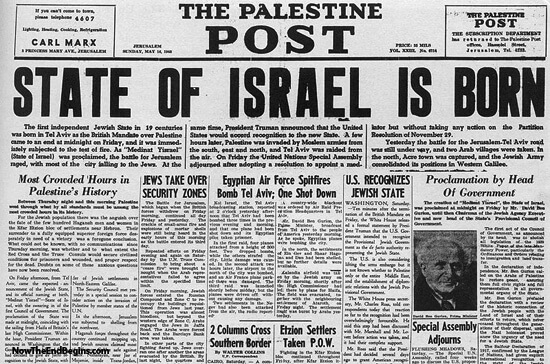
The Jewish people’s connection with the Land of Israel dates back about 4,000 years. The international legitimacy of a Jewish national home in Palestine was recognised by the League of Nations in 1922. Facilitating its establishment was an express condition of the Mandate granted by the League to Britain to govern the country. The Jewish population rose from about 80,000 in 1922 to about 450,000 in 1939 (30 per cent of the total).
After the war, some 230,000 Jewish refugees and concentration camp survivors were held as Displaced Persons in camps in Europe. Most of the surviving Jews were unable and unwilling to return to their pre-war homes in Europe because of the prevalence of violent antisemitism. Some nations, including Australia, were prepared to accept a small number of Jewish survivors. But the door remain closed in most countries, including the United States, which were seeking to recover from the war effort. Most Jewish survivors therefore sought the right to return instead to the historical national home of the Jewish people in then- former Palestine.
Britain was anxious to protect its Middle East interests and maintain favour with the Arab world. The British authorities continued to use force to turn back boatloads of Jewish refugees from then- former Palestine and restrict Jewish immigration into the country. A Jewish revolt broke out as a result. Arab revolts against Jews and the British had begun as early as 1920 and raged in 1921, 1929 and again between 1936 and 1939.
In February 1947 the British announced that they would leave the country and hand over its administration to the United Nations. On 29 November 1947 the UN General Assembly passed Resolution 181, endorsing the partition of Palestine into two separate states: one Jewish and one Arab. Israel declared its independence as the state of the Jewish people on 14 May 1948. The Arabs rejected the Partition Plan and, instead of establishing their own state when the British left, immediately launched a military invasion, seeking to destroy the newly-established Jewish state. One per cent of Israel’s population fell in this war, many of them Holocaust survivors.
It has often been claimed, falsely, that the establishment of the State of Israel was a direct result of the Holocaust. In fact, the foundations and infrastructure of a sovereign Jewish state were built between the mid nineteenth century and Israel’s Declaration of Independence on May 14, 1948. During that period, the emerging Jewish community in former Palestine developed a thriving economy, including a national bank, and many of present-day Israel’s economic and civil society institutions – the kibbutz movement, a free press, the Histadrut trade union movement, national theatre and a vibrant Hebrew-language literary movement. A nascent Jewish government, the Jewish Agency, police force and defence force were also established during this period. A Jewish state in everything but name was already functioning in former Palestine well before the Holocaust.
Nor is there any truth in the claim that large numbers of Holocaust survivors entered the country before Israel was established. The British policy of forcibly barring the entry of Jewish refugees into the country between the end of World War II in 1945 and the end of the British Mandate in 1948 ensured that only small numbers of Jews were able to enter the country during this period. The overwhelming majority of Holocaust survivors who entered the country did so in the years after Israel was established and opened its borders to them.
Professor Yehuda Bauer, one of the world’s foremost historians of the Holocaust, has written that the devastation wrought by the Holocaust on the Jewish people actually impeded, rather than assisted, the establishment of Israel, and that mere public sympathy for the suffering of the Jewish people in fact counted for little in international diplomacy –FULL ARTICLE
